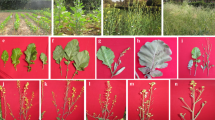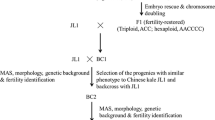Abstract
Breeding at both interspecific and intergeneric levels is an effective method for expanding genetic variation of cruciferous crops; however, few commercially accepted varieties have been released because of difficulties in generating fertile progenies. We employed backcross strategy to introduce Eruca vesicaria-specific characteristics into Brassica rapa and successfully obtained four BC1F1 lines that showed a wide range of diversity of morphological traits and glucosinolate (GSL) composition. Thus, leaf shape, anthocyanin coloration, glucoraphanin content, and red petal veins were found to be inherited mainly from E. vesicaria, though most of the morphological characteristics and GSL composition were inherited from intergeneric F1 plants. Since all BC1F1 lines showed post-fertilization barriers, backcrossing with B. rapa was performed and BC2F1 progenies were successfully obtained, which showed diverse morphological characteristics and GSL composition as well as higher regeneration potential. These results suggest that widening of genetic diversity of B. rapa can be achieved through successive reciprocal backcrossing of B. rapa × E. vesicaria hybrids with B. rapa.



Similar content being viewed by others
References
Agnihotri A, Gupta V, Lakshmikumaran MS, Shivanna KR, Prakash S, Jagannathan V (1990) Production of Eruca-Brassica hybrids by embryo rescue. Plant Breed 104:281–289. https://doi.org/10.1111/j.1439-0523.1990.tb00437.x
Bennet RN, Mellon FA, Botting NP, Eagles J, Rosa EAS, Williamson G (2002) Identification of the major glucosinolate (4-mercaptobutyl glucosinolate) in leaves of Eruca sativa L. (salad rocket). Phytochemistry 61:25–30. https://doi.org/10.1016/S0031-9422(02)00203-0
Bell L, Wagstaff C (2014) Glucosinolates, myrosinase hydrolysis products and flavonols found in Rocket (Eruca sativa and Diplotaxis tenuifolia). J Agric Food Chem 62:4481–4492. https://doi.org/10.1021/jf501096x
Bell L, Methven L, Signore A, Oruna-Concha MJ, Wagstaff C (2017) Analysis of seven salad rocket (Eruca sativa) accessions: the relationships between sensory attributes and volatile and non-volatile compounds. Food Chem 218:181–191. https://doi.org/10.1016/j.foodchem.2016.09.076
Bell L, Wagstaff C (2019) Rocket science: a review of phytochemical & health-related research in Eruca & Diplotaxis species. Food Chem X 1:100002. https://doi.org/10.1016/j.fochx.2018.100002
Ding L, Zhao Z-g, Ge X-H, Li Z-Y (2013) Intergeneric addition and substitution of Brassica napus with different chromosomes from Orychophragmus violaceus: phenotype and cytology. Sci Hortic 164:303–309. https://doi.org/10.1016/j.scienta.2013.09.043
Fechner J, Kaufmann M, Herz C, Eisenshmidt D, Lamy E, Kroh LW, Hanschen FS (2018) The major glucosinolate hydrolysis product in rocket (Eruca sativa L.), sativin, is 1,3-thiazepane-2-thione: elucidation of structure, bioactivity, and stability compared to other rocket isothiocyanates. Food Chem 261:57–65. https://doi.org/10.1016/j.foodchem.2018.04.023
FitzJohn RG, Armstrong TT, Newstrom-Lloyd LE, Wilton AD, Cochrane M (2007) Hybridisation within Brassica and allied genera: evaluation of potential for transgene escape. Euphytica 158:209–230. https://doi.org/10.1007/s10681-007-9444-0
Friedt W, Tu J, Fu T (2018) Academic and economic importance of Brassica napus rapeseed. In: Liu S, Snowdon R, Chalhoub B (eds) The Brassica napus genome. Springer Nature, Cham, pp 1–20. https://doi.org/10.10007/978-3-319-43694-4
Ishida M, Okuyama Y, Takahata Y, Kaizuma N (1995) Varietal diversity of seed glucosinolates content and its composition in Japanese winter rape (Brassica napus L.). Jpn J Breed 45:357–364. https://doi.org/10.1270/jsbbs1951.45.357
Ishida M, Kakizaki T, Ohara T, Morimitsu Y (2011) Development of a simple and rapid extraction method of glucosinolates from radish roots. Breed Sci 61:208–211. https://doi.org/10.1270/jsbbs.61.208
Ishida M, Hara M, Fukino N, Kakizaki T, Morimitsu Y (2014) Glucosinolate metabolism, functionality and breeding for the improvement of Brassicaceae vegetables. Breed Sci 64:48–59. https://doi.org/10.1270/jsbbs.64.48
Kaneko Y, Bang SW, Matsuzawa Y (2009) 11 Distant hybridization. In: Gupta SK (ed) Biology and breeding crucifers. Taylor & Francis Group, New York, pp 207–247
Kaneko Y, Bang SW (2014) Interspecific and intergeneric hybridization and chromosomal engineering of Brassicaceae crops. Breed Sci 64:14–22. https://doi.org/10.1270/jsbbs.64.14
Kaminishi A, Miyohashi F, Kikuchi S, Koba T, Yoshida M, Kita N (2017) Glucosinolate and isothiocyanate composition in an intergeneric hybrid generated by crossing Brassica rapa L. with Eruca sativa Mill. Hortic Res 16:265–271. https://doi.org/10.2503/hrj.16.265
Kim SJ, Jin S, Ishii G (2004) Isolation and structural elucidation of 4-(β-D-glucopyranosyldisulfanyl) butyl glucosinolate from leaves of rocket salad (Eruca sativa L.) and its antioxidative activity. Biosci Biotechnol Biochem 68:2444–2450. https://doi.org/10.1271/bbb.68.2444
Kumar S, Stecher G, Li M, Knyaz C, Tamura K (2018) MEGA X: Molecular evolutionary genetics analysis across computing platforms. Mol Biol Evol 35:1547–1549. https://doi.org/10.1093/molbev/msy096
Matsuzawa Y, Mekiyanon S, Kaneko Y, Bang SW, Wakui K, Takahata Y (1999) Male sterility in alloplasmic Brassica rapa L. carrying Eruca sativa cytoplasm. Plant Breed 118:82–84. https://doi.org/10.1046/j.1439-0523.1999.118001082.x
Mizushima U (1950a) Karyogenetic studies of species and genus hybrids in the tribe Brassiceae of Cruciferae. Tohoku J Agric Res 1:1–14
Mizushima U (1950b) On several artificial allopolyploides obtained in the tribe Brassiceae of Cruciferae. Tohoku J Agric Res 1:15–27
Murashige T, Skoog F (1962) A revised medium for rapid growth and bio assays with tobacco tissue cultures. Physiol Plant 15:473–497. https://doi.org/10.1111/j.1399-3054.1962.tb08052.x
Osada S, Aoyagi Y (2014) Level of glucosinolates in Brassicaceae vegetables harvested during autumn and winter in Japan. J Integr Stud Diet Habits 25:121–130. https://doi.org/10.2740/jisdh.25.121
Raffo A, Masci M, Moneta E, Nicoli S, del Pulgar JS, Paoletti F (2018) Characterization of volatiles and identification of odor-active compounds of rocket leaves. Food Chem 240:1161–1170. https://doi.org/10.1016/j.foodchemi.2017.08.009
Rahman MH (2004) Optimum age of siliques for rescue of hybrid embryos from crosses between Brassica oleracea, B. rapa and B. carinata. Can J Plant Sci 84:965–969. https://doi.org/10.4141/P04-003
Ripa RS, Arif MR, Islam MT, Robin AHK (2020) Embryo rescue response and genetic analyses in interspecific crosses of oilseed Brassica species. In Vitro Cell Dev Biol Plant 56:682–693. https://doi.org/10.1007/s11627-020-10116-6
Sasaki K, Takahashi T (2002) A flavonoid from Brassica rapa flower as the UV-absorbing nectar guide. Phytochemistry 61:339–343. https://doi.org/10.1016/S0031-9422(02)00237-6
Velasco P, Rodriguez VM, Francisco M, Cartea ME, Soengas P (2017) Genetics and breeding of Brassica crops. In: Merillon JM, Ramawat KG (eds) Glucosinolates. Springer International Publishing AG, Cham, pp 61–86. https://doi.org/10.1007/978-3-319-25462-3
Yu F, Lydiate DJ, Gugel RK, Sharpe AG, Rimmer SR (2012) Introgression of Brassica rapa subsp. sylvestris blackleg resistance into B. napus. Mol Breed 30:1495–1506. https://doi.org/10.1007/s11032-012-9735-6
Zhang X, Liu T, Li X, Duan M, Wang J, Qiu Y, Wang H, Song J, Shen D (2016) Interspecific hybridization, polyploidization, and backcross of Brassica oleracea var. alboglabra with B. rapa var. purpurea morphologically recapitulate the evolution of Brassica vegetables. Sci Rep 6:18618. https://doi.org/10.1038/srep18618
Acknowledgements
The authors would like to thank Pro. Bang at Utsunomiya University, Mr. Serizawa at the Nagano Vegetable and Ornamental Crops Experiment Station, Mr. Yoshida and Mr. Tomita at Kanagawa Agricultural Technology Center, Ms. Miyazawa and Ms. Kai at Kanagawa Prefectural Institute of Public Health. We would like to extend our special thanks to the technical staffs, Ms. Takahashi and Ms. Nakata at Kanagawa Agricultural Technology Center. The authors would like to thank Enago (www.enago.jp) for the English language review.
Funding
This research received no specific grant from any funding agency in the public, commercial, or not-for-profit sectors.
Author information
Authors and Affiliations
Contributions
AK: developed the plants, conducted the experiments, and analyzed the data. FM: partly participated in the experiments. NK: conceived the project, designed the research, and critically reviewed and improved the final manuscript.
Corresponding author
Ethics declarations
Competing interests
The authors have no relevant financial or non-financial interests to disclose.
Additional information
Publisher's Note
Springer Nature remains neutral with regard to jurisdictional claims in published maps and institutional affiliations.
Supplementary Information
Below is the link to the electronic supplementary material.
Rights and permissions
About this article
Cite this article
Kaminishi, A., Miyohashi, F. & Kita, N. Diversity of morphological traits and glucosinolate composition in backcross progenies of Brassica rapa L. × Eruca vesicaria (L.) Cav. hybrids. Euphytica 218, 114 (2022). https://doi.org/10.1007/s10681-022-03056-2
Received:
Accepted:
Published:
DOI: https://doi.org/10.1007/s10681-022-03056-2




